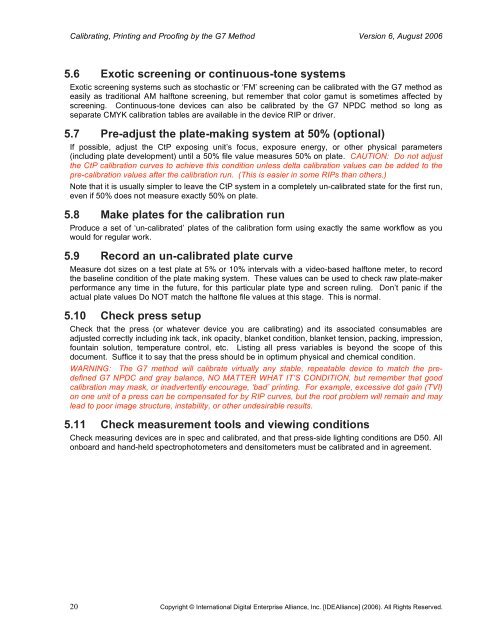Calibrating, Printing and Proofing by the G7™ Method
Calibrating, Printing and Proofing by the G7™ Method
Calibrating, Printing and Proofing by the G7™ Method
You also want an ePaper? Increase the reach of your titles
YUMPU automatically turns print PDFs into web optimized ePapers that Google loves.
<strong>Calibrating</strong>, <strong>Printing</strong> <strong>and</strong> <strong>Proofing</strong> <strong>by</strong> <strong>the</strong> G7 <strong>Method</strong> Version 6, August 2006<br />
5.6 Exotic screening or continuous-tone systems<br />
Exotic screening systems such as stochastic or ‘FM’ screening can be calibrated with <strong>the</strong> G7 method as<br />
easily as traditional AM halftone screening, but remember that color gamut is sometimes affected <strong>by</strong><br />
screening. Continuous-tone devices can also be calibrated <strong>by</strong> <strong>the</strong> G7 NPDC method so long as<br />
separate CMYK calibration tables are available in <strong>the</strong> device RIP or driver.<br />
5.7 Pre-adjust <strong>the</strong> plate-making system at 50% (optional)<br />
If possible, adjust <strong>the</strong> CtP exposing unit’s focus, exposure energy, or o<strong>the</strong>r physical parameters<br />
(including plate development) until a 50% file value measures 50% on plate. CAUTION: Do not adjust<br />
<strong>the</strong> CtP calibration curves to achieve this condition unless delta calibration values can be added to <strong>the</strong><br />
pre-calibration values after <strong>the</strong> calibration run. (This is easier in some RIPs than o<strong>the</strong>rs.)<br />
Note that it is usually simpler to leave <strong>the</strong> CtP system in a completely un-calibrated state for <strong>the</strong> first run,<br />
even if 50% does not measure exactly 50% on plate.<br />
5.8 Make plates for <strong>the</strong> calibration run<br />
Produce a set of ‘un-calibrated’ plates of <strong>the</strong> calibration form using exactly <strong>the</strong> same workflow as you<br />
would for regular work.<br />
5.9 Record an un-calibrated plate curve<br />
Measure dot sizes on a test plate at 5% or 10% intervals with a video-based halftone meter, to record<br />
<strong>the</strong> baseline condition of <strong>the</strong> plate making system. These values can be used to check raw plate-maker<br />
performance any time in <strong>the</strong> future, for this particular plate type <strong>and</strong> screen ruling. Don’t panic if <strong>the</strong><br />
actual plate values Do NOT match <strong>the</strong> halftone file values at this stage. This is normal.<br />
5.10 Check press setup<br />
Check that <strong>the</strong> press (or whatever device you are calibrating) <strong>and</strong> its associated consumables are<br />
adjusted correctly including ink tack, ink opacity, blanket condition, blanket tension, packing, impression,<br />
fountain solution, temperature control, etc. Listing all press variables is beyond <strong>the</strong> scope of this<br />
document. Suffice it to say that <strong>the</strong> press should be in optimum physical <strong>and</strong> chemical condition.<br />
WARNING: The G7 method will calibrate virtually any stable, repeatable device to match <strong>the</strong> predefined<br />
G7 NPDC <strong>and</strong> gray balance, NO MATTER WHAT IT’S CONDITION, but remember that good<br />
calibration may mask, or inadvertently encourage, ‘bad’ printing. For example, excessive dot gain (TVI)<br />
on one unit of a press can be compensated for <strong>by</strong> RIP curves, but <strong>the</strong> root problem will remain <strong>and</strong> may<br />
lead to poor image structure, instability, or o<strong>the</strong>r undesirable results.<br />
5.11 Check measurement tools <strong>and</strong> viewing conditions<br />
Check measuring devices are in spec <strong>and</strong> calibrated, <strong>and</strong> that press-side lighting conditions are D50. All<br />
onboard <strong>and</strong> h<strong>and</strong>-held spectrophotometers <strong>and</strong> densitometers must be calibrated <strong>and</strong> in agreement.<br />
20 Copyright © International Digital Enterprise Alliance, Inc. [IDEAlliance] (2006). All Rights Reserved.


